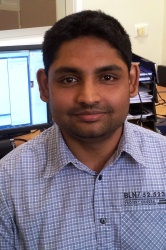Profile
 Mr Thushara Perera
Mr Thushara Perera
Bionics Institute
Course of study:
Bachelor of Electronic Engineering / Master of Biomedical Engineering (Double degree), PhD 2008
Has your degree at La Trobe prepared you well for the workplace?
I have had the pleasure of studying at La Trobe University’s Department of Electronic Engineering for eight years. During that time I have been privileged enough to be taught by excellent lecturers and tutors who are both engaging and knowledgeable about their respective fields. Many of the staff are happy to talk and give assistance whenever possible, even on public holidays! Everyone is supportive, passionate and dedicated. I have maintained friendships and collaborations beyond graduation.
Tell us a little about your work history
I began working as a part-time Biomedical Engineer at the Royal Children’s Hospital during my PhD candidature. I was responsible for the redevelopment of an outdated audiometer that was custom-designed back in the late 1980s. This project involved a lot of signal processing, software and hardware design – things I felt comfortable with because of my studies at La Trobe.
After completing my PhD, I joined the Bionics Institute as a Research Engineer and began working on the Bionic Eye project. Through the course of one year I developed clinical software to interface with a prototype retinal implant. This software provided the platform for clinicians to send information to the Bionic Eye and record patient responses. The Bionic Vision Australia team successfully implanted three blind patients with the Bionic Eye and we continue to make new discoveries about human vision using the software I helped develop.
At present, I have switched my focus to Neurobionics (still at the Bionics Institute). My aim is to help those who suffer from motor disorders such as Essential Tremor and symptoms of Parkinson’s Disease. I’m working closely with clinical Neurologists to develop tools to help optimise treatment for these patients, most of whom have Deep Brain Stimulation implants.
What are things you enjoy most about your job?
The most memorable experience of my career was when the very first Bionic Eye implant was switched on. I was in the test room with the patient, our project leader, an engineer and of course the guide dog! All nervously waiting – checking everything was ready and making final preparations. The patient even commented that it was as if we were preparing to launch a space shuttle. The time finally came when we’d begin to send small electrical pulses to the implant. We slowly increased the size of the electric current, until suddenly the patient told us that she saw something – a flash of light. We tried again, and the patient responded in delight. Success! Everyone in the room let out a sigh of relief as years of hard work by countless experts had finally paved the way to an Australian first. The clinician in charge couldn’t contain his excitement; he was jumping in his chair. Unfortunately, the guide dog had no idea what was going on… she was fast asleep, snoring away!
The best thing about my job is that I get to see the work I do have a positive impact on patients. The tools and devices I design are used by patients and clinicians. Then, with their feedback, I’m able to improve them even further.
What advice can you offer to current students?
Don’t just go to lectures and learn the theory – be active, join clubs and play a sport. The communication, teamwork and networking skills you develop are very important and help you get your foot in the door for job interviews.
No results were found
